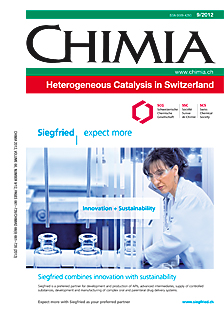Spectroscopic Detection of Active Species on Catalytic Surfaces: Steady-State versus Transient Method
DOI:
https://doi.org/10.2533/chimia.2012.664Keywords:
Co hydrogenation, Diffuse reflectance infrared spectroscopy, Heterogeneous catalysis, In situ spectroscopy, Modulation excitation spectroscopyAbstract
Discrimination between active and spectator species is an important and demanding task in catalysis research. A comparative study of the Pd-catalyzed CO hydrogenation using in situ diffuse reflectance IR Fourier transform spectroscopy (DRIFTS) in steady-state and dynamic (transient) experiments shows that the information on surface species differs significantly depending on the type of experiment. In order to discriminate between active species and spectator species not involved in the surface reactions, DRIFTS was combined with a transient technique, modulation excitation spectroscopy (MES). This approach allows the detection of surface species responding to a specific periodic external stimulus, i.e.achieved by concentration modulation, and thereby offers excellent potential to unveil features of the surface processes, which are not accessible by steady-state experiments. However, the example of CO hydrogenation shows that the perturbation imposed to the system has to be chosen properly to benefit from the transient technique. Modulation of the CO concentration did not provide deeper insight into the reaction mechanism, whereas periodic changes of the hydrogen concentration provided valuable information concerning the active surface species and the reaction pathway. The study revealed that only a small fraction (about 4%) of CO molecules adsorbed on specific Pd sites reacted with hydrogen, while the majority of adsorbed CO was inactive. The inactive CO molecules overwhelmingly contributed to the spectra measured under steady-state conditions.Downloads
Published
2012-09-26
How to Cite
[1]
N. Maeda, F. Meemken, K. Hungerbühler, A. Baiker, Chimia 2012, 66, 664, DOI: 10.2533/chimia.2012.664.
Issue
Section
Scientific Articles
License
Copyright (c) 2012 Swiss Chemical Society

This work is licensed under a Creative Commons Attribution-NonCommercial 4.0 International License.







